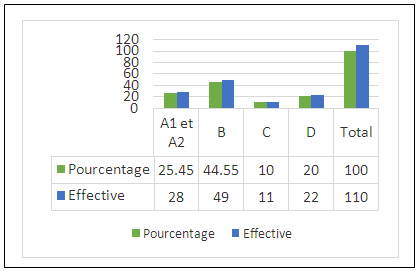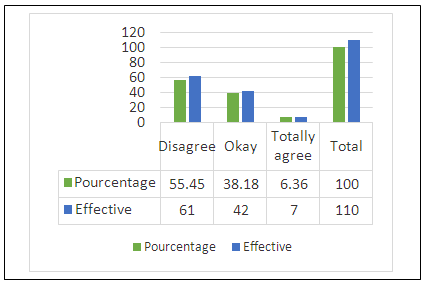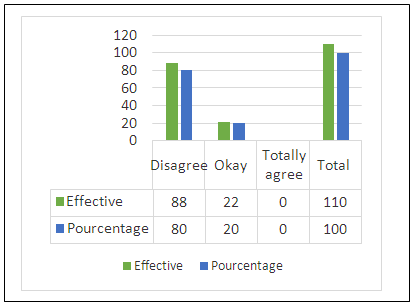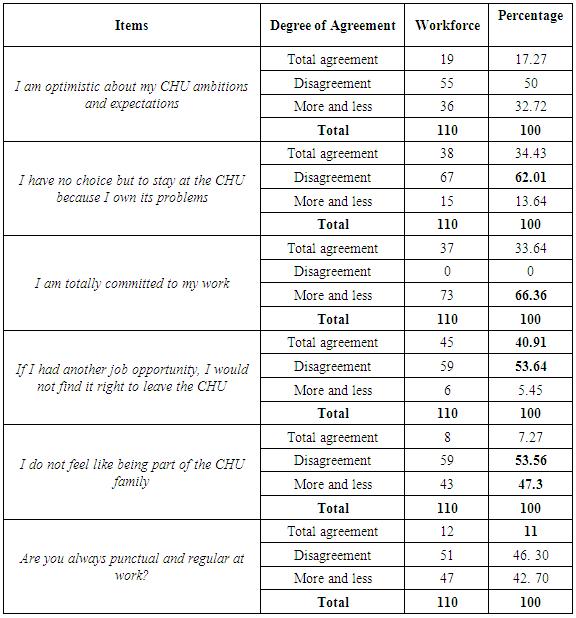-
Paper Information
- Previous Paper
- Paper Submission
-
Journal Information
- About This Journal
- Editorial Board
- Current Issue
- Archive
- Author Guidelines
- Contact Us
International Journal of Applied Psychology
p-ISSN: 2168-5010 e-ISSN: 2168-5029
2019; 9(1): 40-45
doi:10.5923/j.ijap.20190901.05

Impact of Distributive Justice on the Involvement at Work
Badji Ouyi
Department of Applied Psychology, Institut National des Sciences de l’Education, Université de Lomé, Lome, Togo
Correspondence to: Badji Ouyi, Department of Applied Psychology, Institut National des Sciences de l’Education, Université de Lomé, Lome, Togo.
| Email: |  |
Copyright © 2019 The Author(s). Published by Scientific & Academic Publishing.
This work is licensed under the Creative Commons Attribution International License (CC BY).
http://creativecommons.org/licenses/by/4.0/

This study focuses on the impact of the distributive justice on the involvement of the staff from Sylvanus Olympio Teaching Hospital (CHU SO) in the work. It covered a sample of 110 employees paid by the self-supporting budget of the CHU SO. A data processing and analysis through quantitative and qualitative methods were carried out to verify the influence of the distributive justice on the involvement of the CHU SO employees. The results of this study suggest a relationship between the different elements (wage policy, work environment, participation in training ...) of the distributive justice mechanism and the involvement in the work. All the relationships are significant and confirm the importance of the distributive justice in the involvement of the employees in the workplace.
Keywords: Impact, Distributive justice, Involvement in the work
Cite this paper: Badji Ouyi, Impact of Distributive Justice on the Involvement at Work, International Journal of Applied Psychology, Vol. 9 No. 1, 2019, pp. 40-45. doi: 10.5923/j.ijap.20190901.05.
1. Introduction
- The distributive justice is a dimension of the organizational justice and refers to how employees perceive the distribution of allowances and compensations in an organizational context [1-4]. Concretely speaking, the compensations can take many forms, such as monetary (salary, bonuses, allowances, etc.) or non-monetary, such as incentives or promotional opportunities. An employee is able to assess the distributive component of the organizational justice by comparing his or her compensations to those received by another employee who is part of the same organizational context or who is doing the same work as he or she does. This assessment refers to the theory of equity developed by [5]. According to this theory, the employees compare the ratio of their perceived compensation (earnings and benefits) and their perceived contribution (effort, performance) with the corresponding ratio of other workers [6]. If the ratios are not equal, the worker with the higher ratio is unfairly overpaid (he or she feels guilty) and the worker with the lower ratio is unfairly underpaid (he or she feels frustrated). According to this theory, the equal ratios lead to a state of equity, which in turn leads to a sense of achievement. Although this theory has been modified and refined over the years, the concepts of equity and social comparisons have remained in subsequent models.Many equity theorists agree that the comparisons with others are not the only way for employees to determine whether they are fairly or unfairly paid. According to [7], a worker, when assessing the justice of his/her salary, can compare himself or herself with others but can also use the system or himself/herself as a reference. According to the author, the word “system” means the use of the contract (implicit or explicit) whereby the employee becomes a member of an organization and receives compensation in exchange for certain contributions. When using himself or herself as a referent, the comparison is done using the result of the current ratio and a previous ratio or a future ratio that can be achieved according to him or her.Today, when we talk about the distributive justice rule, three referents (or types of comparisons) are mentioned. This is the comparison with employees within the organization (internal equity), with oneself or one’s own characteristics (individual equity) and with others outside the organization (external equity).A study carried out by [8] confirms that various concepts of equity do not have the same importance to individuals. Their study accesses the relevance of the three types of equity as referents in the assessment of the processing received by the organization among executives at all levels.This is in line with the studies carried out by [9] on the determinants of the salary satisfaction. Indeed, these researchers find that the comparison with others (external equity) in determining the salary satisfaction is not so obvious (contributing almost nothing to the prediction of salary satisfaction) and deserves more critical consideration. [10] also found similar results.In the 1970s, in the face of the failure of the equity theory to explain all the responses to compensation systems and hoping to achieve a greater understanding of the justice system, some authors came up with alternative rules of distribution [11]. In addition to the equity rule, two other rules were identified. These are the rule based on the needs, that is, the compensation distribution is based on individual needs, and the rule of equality, that is, an absolutely equal distribution among the various employees [12].Based on the needs and mission of the organization, the latter will choose various ways to distribute its resources among the employees. The individuals use the rule of equity when the business aims at maximizing the productivity of the group. They use the rule of needs when the one distributing the compensations is a friend of the employees and they rather use the rule of equality when the organization aims at harmonizing and minimizing conflicts [13].The scientific literature shows that the distributive justice has significant effects. [14] find an indirect link, via job satisfaction, between the pay equity and involvement in the work. The involvement in the work leads to some desirable behaviors for the organization, such as helping a colleague with problems, tolerating inconvenience without complaining, promoting a positive environment, protecting the resources of the organization. The results of their research show that in people who are already satisfied at work, an equity perception will lead them to be more involved.Indeed, the involvement in the work is defined as a general force that leads the employee to identify and commit himself or herself to the organization in which he or she works [15]. The involvement in this research will refer specifically to: punctuality and regularity at work, attendance at work, speed of work, enthusiasm and efficiency at work, dedication to work and desire for a career advancement in the organization. This definition is based on the moral involvement concept of [16] and the attitude involvement of [17]. Therefore, this study aims at understanding the link between the distributive justice and the involvement in the work observed among the employees of a Teaching Hospital.
2. Methodology
- In order to achieve the collection of reliable information that can be used to verify the influence of the distributive justice on the behavior of involvement in the work, we chose to limit the study to employees that are paid by the self-supporting budget of the Teaching Hospital (CHU) SO. The Hospital is located in the heart of Lomé on a hill at the Centre - West of the Lomé –Tokoin area.From a non-stratified sampling, the so-called «anybody » method, 137 employees all categories included agreed to complete the questionnaire out of a total of about 450 employees. After collecting and processing the questionnaires, only 110 were successfully completed and therefore considered workable. This number then forms the study sample.For the pre-survey, we opted for a direct and participatory observation supplemented by four (04) exploratory semi-zzdirective interviews. Regarding the survey itself, a questionnaire is used for the collection of information. We used the direct administration technique of the questionnaire because the sample is made up of educated people.The questionnaire distributed included 32 questions. This is indeed a Likert-type questionnaire, where the respondents must indicate their level of agreement on an assessment scale ranging from 1 to 3 (disagreement, agreement and total agreement). Note that the proposed responses are odd in order to guide the undecided towards these choices, but less accurate in order to avoid the random answers.Therefore, to assess the distributive justice, we use the scale developed by [18]. With this scale of 4 items that assesses only the internal equity of the distributive justice, a complement of 9 other items developed from the definitions of the authors such as [19-21] in order to assess the external equity. A questionnaire developed based on the scale of [22] translated into French by [23] is used to assess the involvement behavior of the employees of CHU SO.For the data processing, we used statistics, which allow us to calculate the percentages, frequencies and indices of relationships between the variables.By the way, all of these calculations were done using the statistical program SPSS 17.0 (Statistique Package of Social Science).To analyze the data collected, we opted for the semantic software method. It takes into account the obvious content.Characteristics of the Sample- Age of the respondentsIdentifying the age group of the respondents in the scientific research is important because the sensitivity to problems is not the same in the adults as in the youth. Therefore, the age of the respondents to the research questions plays a role in the reliability of the information collected.
 | Chart 1. Distribution of the respondents per Age |
 | Chart 2. Distribution of the respondents per education level |
|
|
3. Results
- The Teaching Hospital (CHU-SO) assigns to all the jobs within itself a minimal opportunity for motivation. So, depending on the responsibilities, the jobs and their characteristics, benefits are granted to motivate the employees. The characteristics of the duty represent all the stable aspects of the work environment related to this job. All these characteristics are distributed per key components that are the variety of skills mobilized, task identification, autonomy, feedback. These characteristics are a factor of moral comfort that evokes positive collective attitudes such as a sense of collective justice. On the industrial relations level, however, there are discriminatory fears.For example, all the employees of CHU-SO receive a contagion risk bonus per socio-professional category because of their exposure to diseases. But the problem is the distribution of these bonuses, and the responding agents are 82% opposed to equity in the distribution of the bonus amounts. The trend is not very different in terms of their sense about the designations for training.
 | Chart 3. Distribution of the respondents per participation in training |
 | Chart 4. Distribution of the respondents per sense of equity |
 | Chart 5. Distribution of the respondents per social sense / environment |
|
4. Discussions
- Let’s recall that this study aims at exploring the impact of the distributive justice on the involvement of the teaching hospital employees in the work. So in this section, we shall give a psychological coloration to the results.The literature specialized on the distributive justice shows that there is sometimes an inequity in the treatment of employees in the organizations. In the case of the CHU-SO, the employees do not agree on the practices of the compensation system and on the choices made regarding the participation in the training. The analysis of these results reveals that there is a bonus distribution grid. Moreover, for most of the respondents, the designation procedures for internships, training and seminaries are unfair (Chart 3). These elements sufficiently demonstrate that there is a concern regarding the distributive justice at the CHU SO.Furthermore, Chart 5 shows the existence of a deleterious social environment caused by the accumulated frustrations at the CHU SO. According to the staff, there is an inequity in the distribution of bonuses and the choices for training. The employees compare the ratio of their perceived compensation (bonus and training) and their perceived contribution (workload) with the corresponding ratio of other colleagues and they notice that the ratios are not equal. This situation frustrates and creates a sense of relational dissatisfaction between the employees of CHU-SO. Under these conditions, the industrial relationships can only suffer from inadequacies that will undoubtedly affect the work environment.Our results are consistent with those obtained by [24] who found an indirect link, in terms of job satisfaction, between the pay equity and the involvement in the work. They are in line with [25-28].However, to conclude this section, we note that this study has methodological limitations. On the one hand, it should be noted that the external validity of the research was limited to 110 employees who voluntarily agreed to participate. On the other hand, the use of the questionnaire to collect as much information as possible by touching a large number of employees did not allow us to obtain spontaneous information but generated ones. This may not always be consistent with the realities of the field at the CHU-SO. Nevertheless, in order to fill these gaps, we used interviews and observation that allowed us to access certain details to confirm or deny the answers of the respondents.Our objective in this study is to explore the impact of the distributive justice on the involvement in the work. However, we noted that this issue has been subject to very little research, especially in Africa. It has remained virtually unexplored in the hospital sector in Togo. To our knowledge, regardless of the region or sector, no study in Togo has been conducted on the impact of the distributive justice on the involvement in the work in the hospital sector. Hence the originality of this research presented in the academic context.The results of this study allow to have a new perspective on the distributive justice and to deepen the knowledge of the history of the involvement in the work and the manifestations of «non- involvement».
5. Conclusions
- Any organization, whether private or public, will always need Human Resources when it wants to be performing and competitive. However, the practice in terms of Human Resources Management encounters a number of difficulties such as frustration, misunderstanding, conflicts and even the perception of injustice in the distribution of allowances. These factors being able to put the organizations at risk, it is about finding or striving for the best fit, in order to retain and return on investment through human capital productivity. Therefore, it is preferable to gain the trust of its employees and the practice of equity in the distribution of allowances is a variable.It is in this context that this study wanted to explore the impact of the distributive justice perception on the involvement in the work at a Teaching Hospital. The study has the advantage of being carried out on a nearly heterogeneous population of health staff, which helps to understand the manifestations of the distributive justice and its consequences. The study provides information on the distributive justice as well as on the involvement in the work and the behaviors that underlie the «non- involvement». In this regard, it is good to know that a loss of means linked to the iniquity is fatally higher than a gain of means linked to equity. So, if the employers want a good involvement of their employees in at work, a permanent effort will be necessary in terms of distributing the allowances. This would help improve the perception of the distributive justice that could positively affect the involvement and therefore the performance of the workers.
 Abstract
Abstract Reference
Reference Full-Text PDF
Full-Text PDF Full-text HTML
Full-text HTML

